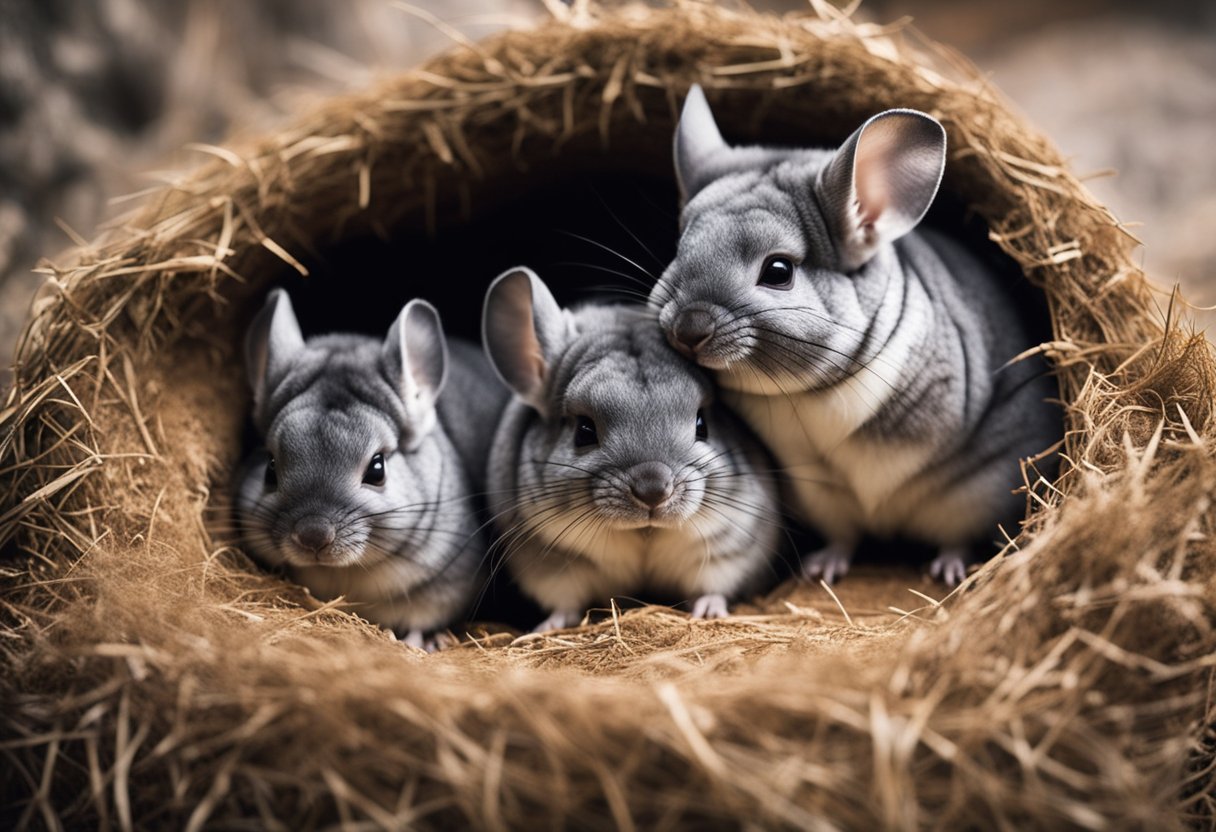Chinchillas are fascinating pets with unique traits and behaviors. One of the questions many owners and potential breeders have is about their reproductive habits. On average, chinchillas have two to four babies, known as kits, in each litter. This number can vary, and understanding how many kits they can have is essential for anyone considering breeding these charming animals.

Their breeding process involves a gestation period of around 110 days, making it vital to provide proper care during this time. As you learn more about chinchilla reproduction, you will discover interesting facts about their young, who are born with fur and open eyes, ready to explore the world almost immediately.
You’ll find that chinchillas are capable of having multiple litters each year, which can lead to many adorable kits in a relatively short time. Learning about these aspects will help you appreciate these small mammals even more.
Key Takeaways
- Chinchillas typically have two to four kits per litter.
- The gestation period for chinchillas is about 110 days.
- Kittens are active and fully furred at birth.
Chinchilla Reproduction Basics

Chinchilla reproduction involves several key factors, including their breeding age, mating behaviors, and gestation period. Understanding these aspects will help you better care for chinchillas during their breeding phase.
Breeding Age and Maturity
Chinchillas reach sexual maturity between 5 to 10 months of age. Females usually mature faster than males. It’s essential to allow them to grow properly before breeding, as breeding too young can lead to health issues.
You can identify the right breeding age by observing their behavior. Look for signs of interest in mating, such as increased activity or vocalizations. Mature males will also develop larger testicles, which is a sign they are ready to mate.
It’s vital to breed only healthy chinchillas. Regular vet check-ups can help ensure they are fit for breeding. Moreover, you should avoid breeding closely related chinchillas to prevent genetic problems in the offspring.
Mating Behaviors
Chinchillas are generally social animals, but their mating behavior can vary. Mating often occurs in cooler months, which aligns with their natural instincts. Males will display courtship behaviors, like chasing and grooming, to attract the female.
You may notice that once a female is in heat, she will show more interest in the male. This period lasts around 24 to 48 hours. During this time, successful mating is more likely.
In some cases, chinchillas may mate many times over a few days. This behavior increases the chances of pregnancy. Pay attention to both chinchillas as they should be healthy and comfortable with each other for successful mating.
Gestation Period
The gestation period for chinchillas lasts about 110 to 120 days. This long pregnancy allows kits to develop fully. Female chinchillas typically give birth early in the morning.
Kits are born with fur, open eyes, and the ability to run shortly after birth. This readiness to move is crucial for their survival. A female may have 1 to 4 kits per litter, depending on her health and age.
Breeding typically occurs 1 to 3 times per year. After birth, it is essential to ensure the mother has a suitable environment to care for her young. Kits will remain with their mother for about 6 to 8 weeks before weaning.
Offspring Details

Chinchillas have interesting characteristics when it comes to having babies. Understanding litter size, care for newborns, and their growth milestones can help you provide better care for these pets.
Litter Size and Frequency
Chinchillas typically have a litter size that varies. On average, you can expect 2 kits per litter, although it is possible for them to have as few as 1 or as many as 6 kits at a time. The most common scenario involves 2 to 4 kits.
Chinchillas usually have 1 to 3 litters per year. The timing can depend on factors such as the health of the mother and the breeder’s practices. This breeding pattern makes chinchillas relatively prolific for small mammals.
Newborn Care Requirements
When chinchilla kits are born, they come into the world fully furred and with their eyes open. They are quite independent and can even start moving shortly after birth. However, care is crucial during their early days.
It’s important to ensure that the mother has a clean and safe environment. Fresh food and water should always be available. Kits nurse for about 6-8 weeks, relying on the mother’s milk for nutrition.
A balanced diet and proper hydration are vital for the mother during this time to support her health and milk production.
Chinchilla Growth Milestones
Baby chinchillas grow rapidly. Within a few days, they become more active and curious. By 3 weeks, they start to eat solid food and can often be seen nibbling on hay and pellets.
At about 8 weeks, they are usually ready to be separated from their mother. They continue to grow and develop, reaching sexual maturity around 8-12 months of age. During their early months, regular health checks can help ensure they are growing properly and staying healthy.
Resources
For further information on chinchilla care and breeding, you may want to explore articles and guides available online. Great resources include How Many Babies Do Chinchillas Have? and Chinchilla Babies: Litter Size and Care Guide. These can provide you with more in-depth knowledge about this topic.
Frequently Asked Questions

You may have questions about chinchilla reproduction and care. Here you’ll find detailed answers regarding their litter sizes, mating habits, and the care of baby chinchillas.
What is the average number of offspring per litter for a chinchilla?
Chinchillas usually have an average of two baby chinchillas, known as kits, per litter. They can have as few as one or as many as four kits at a time.
How frequently can chinchillas become pregnant in a given year?
Chinchillas can become pregnant 1 to 3 times each year. The exact number depends on the health of the mother and the conditions set by breeders.
At what age do chinchillas typically cease to reproduce?
Chinchillas can reproduce until they are about 5 to 8 years old. After this age, their fertility may decline.
Can you describe the mating behavior of chinchillas?
Mating in chinchillas involves courtship behaviors. Males may chase and nuzzle females to show interest. Once paired, the actual mating can happen quickly.
How long is the gestation period for chinchillas?
The gestation period for chinchillas is about 111 days. This means that after mating, it takes approximately three and a half months for the kits to be born.
How soon are baby chinchillas weaned from their mother?
Baby chinchillas are typically weaned at about 8 weeks old. By this age, they begin to eat solid food and can start living independently.

